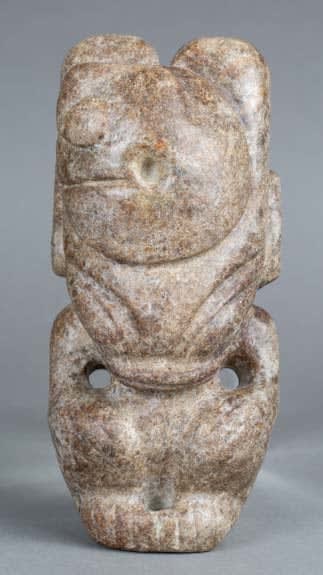Mythical Zoomorphic Figure in Stone
Stone
18 x 8 x 7 cm
7 1/8 x 3 1/8 x 2 3/4 in
7 1/8 x 3 1/8 x 2 3/4 in
CB.3494
Many thousands of years ago, our earliest ancestors were nomadic tribes that survived by foraging the wild for food and shelter. During the Neolithic era, human groups first began to...
Many thousands of years ago, our earliest ancestors were nomadic tribes that survived by foraging the wild for food and shelter. During the Neolithic era, human groups first began to settle down permanently, establishing villages and communities. However, without new technological innovations, this sedentary culture would not have been possible. Foremost among these discoveries were agriculture and tool-making, both of which enabled humans to transform their natural environment into a sustainable society. Many thousands of years ago, the area presently covered by modern China was made up of distinct regions each with their own unique cultural identity. Archaeologists have been able to discern some of these cultures from each other based upon the burial styles, architecture, and pottery, perhaps the most immediate remnant of this age.
This technically-skilled stone carving of a zoomorphic figure dates from this distant era. While the identification of the zoomorphic figure remains a mystery, it almost resembles a crouching mammal with human features. With ears perked upwards, a large bulbous head dwarfs the body below. Shoulders protrude from about cheek-height and arms wrap around the mammal’s knees, creating two rounded holes. The mammal’s knees are bent upwards to the chest and the feet, distinguished by subtle ridges, are pressed together.
Although this artefact may have once served a practical purpose – perhaps in votive offering or memorial – today it is appreciated as a gorgeous work of art, treasured for both its beauty and history alike.
This technically-skilled stone carving of a zoomorphic figure dates from this distant era. While the identification of the zoomorphic figure remains a mystery, it almost resembles a crouching mammal with human features. With ears perked upwards, a large bulbous head dwarfs the body below. Shoulders protrude from about cheek-height and arms wrap around the mammal’s knees, creating two rounded holes. The mammal’s knees are bent upwards to the chest and the feet, distinguished by subtle ridges, are pressed together.
Although this artefact may have once served a practical purpose – perhaps in votive offering or memorial – today it is appreciated as a gorgeous work of art, treasured for both its beauty and history alike.
